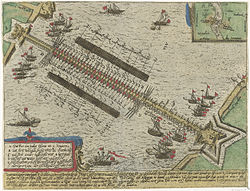Pontoon bridge
A pontoon bridge is a bridge that floats on water. It is a floating bridge with barges or boats ('pontoons') to support the bridge deck.
![U.S. Army troops cross the Rhine on a heavy pontoon bridge, March 1945[1]](https://upload.wikimedia.org/wikipedia/commons/thumb/6/63/US_Army_crossing_the_Rhine_on_heavy_ponton_bridge_at_Worms%2C_March%2C_1945.png/250px-US_Army_crossing_the_Rhine_on_heavy_ponton_bridge_at_Worms%2C_March%2C_1945.png) U.S. Army troops cross the Rhine on a heavy pontoon bridge, March 1945[1] | |
| Carries | Pedestrian, automobile, truck |
|---|---|
| Span range | Short to long |
| Material | Various: steel, concrete, boats, barrels, plastic floats, appropriate decking material |
| Movable | Generally not, but may have movable sections for watercraft passage |
| Design effort | low |
| Falsework required | No |
Pontoon bridges are usually temporary structures, but some are used for long periods. Permanent floating bridges are useful for sheltered (quiet) water-crossings. It may be too expensive to suspend a bridge from anchored piers. Pontoon bridges may need a section that is elevated, or can be raised or removed, to allow ships to pass.
Pontoon bridges are often used in wartime as river crossings. They are usually temporary, and are sometimes destroyed after crossing (to keep the enemy from using them), or collapsed and carried (if on a long march). They were used to great advantage in many battles. Pontoon bridges have been in use since ancient times. It is thought that the first London Bridge was a Roman pontoon bridge. Roman legions had men and equipment to build pontoon bridges, and often made them. The first pontoon bridge was made by the Zhou Dynasty.
Pontoon Bridge Media
Pontoon bridge between Russellville and Dardanelle, Arkansas, US, at the time reportedly the longest pontoon bridge in the world. (Photo c. 1913–1926)
The Bergsøysund Bridge uses concrete pontoons
Mughal emperor Akbar the Great riding the ferocious elephant Hawa'i, pursuing another elephant across a collapsing bridge of boats (left), in Basawan and Chetar Munti's "Akbar's Adventure with the Elephant Hawa’i", dated 1561
A bridge of boats over the Ravi River in British India, 1895
3e régiment du génie (French Wikipedia), The 3rd French Regiment of Pioneers are building a Pontoon Bridge over the river Ourthe in Chênée, Belgium in the 1930s.
Deployment showing automatic unfolding of the most recent Russian ribbon bridge system PP-2005 in 2020
Improved ribbon bridge built by 341st Engineer General Service Regiment at Drawsko Pomorskie training area, 11 June 2018
References
- ↑ Beck, Alfred M., et al., The Corps of Engineers: The War Against Germany, Center of Military History (U.S. Army), 1985. The bridge was built by the 85th Engineer Heavy Combat Battalion on March 26, 1945, 200 feet downstream from the demolished Ernst Ludwig highway bridge. It was named the Alexander Patch Bridge after the Seventh Army commander, General Alexander Patch. A stone tower of the former bridge is visible on the opposite bank.








